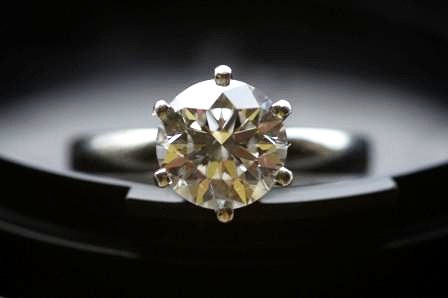
Clean 1+ carat colorless synthetics are hitting the market for the first time, and with a consistent stream of recycled polished making their way back into the market, the dynamics of diamond supply may for forever be changed.
Unprecedented Gem-Quality Synthetics
Last month, a 1.29 carat colorless “E” synthetic with almost no inclusions (the largest of its kind in history) hit the polished diamond market. While synthetics have been produced since the 1950’s, the technology has been primarily used to supply the market with industrial grade stones, not gem-quality diamonds.
The record breaking 1.29 carat stone mentioned above was created using CVD, and is currently on the market for $7,633, about 38% cheaper than a natural equivalent which can currently be found on the market for around $10,500.
The impact that clean, colorless gem-quality synthetics will have on the jewelry market will greatly depend on consumer demand for non-natural diamonds, as synthetics currently only account for approximately 2% of supply. As a proxy, synthetic gem-quality rubies and sapphires have been produced in labs for over 100 years, but their availability has not reduced the demand for natural stones, as the premium for natural over synthetic has held over the years. It will take substantial shifts in marketing campaigns and consumer attitudes for synthetic diamonds to pose a significant threat to natural diamonds in the jewelry market.
On a De Beers conference call in November 2012, when asked if the company is concerned about the impact of synthetics on their natural gem business, an executive said “so, while there may be a business for [lab-growth diamonds], we don’t see that it is a cannibalizing business of ours on the basis that we maintain the dream and the emotion and the symbolism and the luxury and the value associated with the natural diamond.” On the same call De Beers went on to express the importance of disclosure of synthetics to alleviate customer concern of being sold a synthetic when paying for the price of a natural.
Technology has recently been developed capable distinguishing synthetic from natural diamonds in a way that is financially and technically within the reach of jewelers. In addition, there is an inherent incentive for jewelers to use proper disclosure when selling synthetics, as it would be fatal for a jeweler to be caught selling an undisclosed synthetic as a natural.
Synthetic gem-quality diamonds will most likely have a greater impact on technology than jewelry. There is unquestionable pent up demand for more affordable flawless diamonds in the semiconductor industry. Since diamonds have a higher thermal conductivity than any other material, diamond microprocessors can run at speeds that would cause ordinary silicon chips to melt. Flawless synthetics are demanded in other high-tech applications as well, including infrared radiation transmission and high-sensitivity sensors. Up until now, diamond use in high tech industries has been limited because the cost has been prohibitive, but expect new lower price points to unleash years of pent up demand.
Recycling/Re-Selling of Polished
Also impacting global diamond supply is the recycling of polished diamonds, which is by no means a new phenomenon but rarely talked about, and could account for 5-10% of current market supply.
Even at the high end of current estimates, recycling of diamonds relative to supply has been minimal compared to the recycling of other hard assets such as gold. This is primarily because it traditionally has been difficult for consumers to sell-back diamonds.
Despite the liquidity constraints of selling-back diamonds, there have always been instances in which diamonds have been resold. For example, a diamond engagement ring sold regardless of price in an attempt to erase a memory after a divorce, or the desperate pawning of a gold ring with diamonds to payoff a debt. But sales such as these historically have not occurred frequently enough to significantly impact the market.
However, in recent years, as high-quality rough is becoming more difficult to find, and more expensive to produce, the industry is seeing historic levels of recycling as high diamond prices rival the sentimental value of consumers jewelry. In addition to higher prices, the availability of diamond pricing information available to the public on the internet is also leading to more consumers willing to sell-back. As an anecdote, I surveyed some independent jewelers in New York’s diamond district, and it is was not difficult to find a jeweler willing to buy a diamond at a 15-20% discount from the price that they would sell a similar stone. It appears as if people are ‘hitting this bid’ as quite a few of the stores disclosed that up to 25% of their current inventory is recycled.
It’s worth noting that investment in diamonds is becoming increasing popular, especially in Asia, as high-net-worth individuals are buying the rarest high quality diamonds and storing them away in safe boxes. These diamonds are temporarily taken off of the market as they are held in anticipation of price appreciation, and eventually ‘recycled’. The investment community for diamonds is still very small though, estimated to represent less than 1% of current diamond demand (for comparative purposes, gold investment represents 40-50% of current gold demand).
Its difficult to precisely quantify the overall impact that recycling currently has on the market given that most buy-backs take place in non-transparent environments such as independent or “street” jewelers, and pawn shops. Most mainstream jewelers still do not buy-back. In addition, a lot or recycled diamonds are recut by jewelers converting old shapes into more fashionable designs, making tracking recycled diamonds that much more difficult.
Paul Zimnisky, Guest Contributor to MiningFeeds.com
About the author: Paul Zimnisky, has worked in the financial industry for almost 10 years, primarily as a buy-side equity analyst focused on the metals and mining space, and as an ETF arbitrage trader. Paul currently creates and develops new exchange-traded products. Paul has a finance degree from the University of Maryland.



 Follow us on Twitter
Follow us on Twitter Become our facebook fan
Become our facebook fan











Comments are closed.